Introducing s+b’s “Strategy of the Year”
What is 2013’s most in-vogue strategy? Make your nominations.
Take a look at the exploding curve in the exhibit below. It’s taken from Google Book’s Ngram Viewer, which charts word usage in Google’s digitized library over many decades. Here, we’ve tracked the use of “business strategy.”
The growth trajectory shows just how central business strategy has become to the language of commerce. Historically, use of the word strategy was reserved for the military, but as the Mad Men era was reaching its zenith, business started to adopt it with a vengeance. The uptick seemed to begin with “portfolio strategy” during the go-go years of the 1960s and ’70s, and it continued with “competitive strategy” in the 1980s. Then just about everything seemed to become a strategy. Today, we see growth, margin, cost, and shareholder strategies; diversification, focus, expansion, and restructuring strategies; innovation and R&D strategies; sourcing, manufacturing, distribution, and IT strategies; global, local, and even global–local strategies. You name it. The list seems infinite. What’s going on?
What’s going on is a word game. Strategy has been co-opted as a way to lend status, import, and credibility to nearly any enterprise initiative—so much so that it’s now a central feature of business fashion. Remember when “quality strategy” was de rigueur in the 1980s, or when “reengineering strategy” was all the rage in the early ’90s, or how “dot-com strategy” ruled the late ’90s? How about “China strategy” and “blue ocean strategy” in the early 2000s? A few years ago, everyone was asking, “What’s your Google strategy?”
It’s easy to argue that strategy has become so overused as to be almost meaningless. After all, when something starts to mean everything, it often ends up meaning nothing. This is what’s happening to strategy. It’s enough to make a grown strategist cry.
What, then, is a strategist to do? You can’t turn back the tide of how everyday language evolves and how particular words are used. But you can help your business separate the strategic wheat from the chaff.
Any strategy adds value only as far as it sharpens or enhances the answers to five existential questions that every enterprise should be asking itself every day:
1. What business or businesses should you be in?
2. How do you add value to your businesses?
3. Who are the target customers for your businesses?
4. What are your value propositions to those target customers?
5. What capabilities do you need to add value to your businesses and differentiate your value propositions?
I call these the Strategic Five. If you can’t answer these, your strategies—in whatever form they take—are incomplete, misdirected, or, perhaps, mislabeled. But if the Strategic Five remain your true north, your strategies will enhance rather than dilute the coherence of your business (more about this is a future blog post).
Which brings us to the fun part. To celebrate the true role of strategy, the editors of strategy+business and I are inaugurating what we hope will become an annual tradition: Strategy of the Year.
Here’s where you come in.
Put on your strategist cap, plant tongue firmly in cheek, and consider the following: What is this year’s most fashionable strategy? What is this year’s version of the Google or China strategy? Which strategy is on everyone’s lips and decorating their business plans?
Now scroll down to the comments section and nominate your choice for 2013’s Strategy of the Year. Remember, we are looking for that one version of strategy that truly came into its own during the past 12 months across a range of companies, industries, and geographies. Not any single company’s strategy, but one that is now in fashion broadly.
Have at it!
I’ll be back the week of January 6 to announce this year’s winner.






